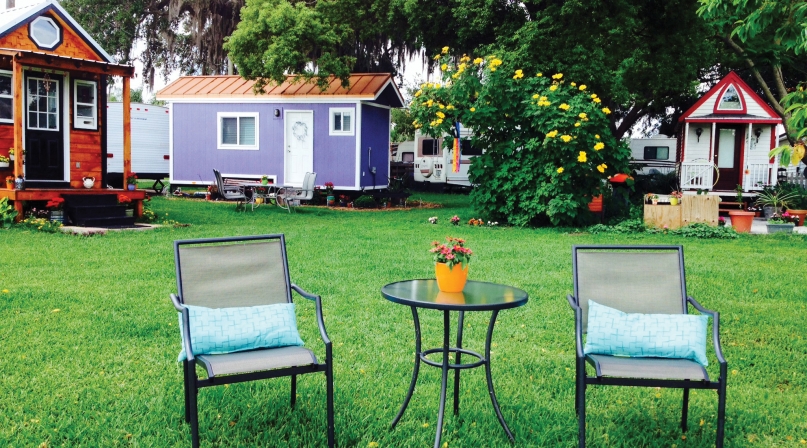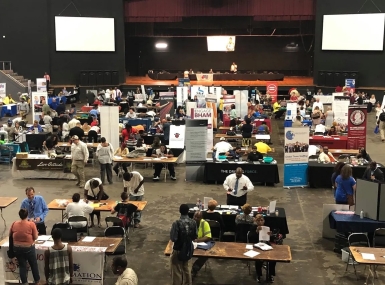| |
- County officials are looking at tweaking zoning and building ordinances in response to their residents’ interest in tiny houses — which generally range from 200 square feet to 500 square feet in size.
- They appeal to homeowners looking for lower costs and a smaller footprint.
Tim Fitzgerald was surprised by the turnout for a Tiny House Forum in Staunton, Va. this spring. He’s community development director for Augusta County, which surrounds the city, the county seat.
“When I went to this forum, I was thinking maybe we’d have 10 or 15 people, and the room was full. There were probably 60 folks there,” he said. “There was quite a bit more interest in it than anticipated.”
Whether the “tiny house movement” is a ripple or a wave, county officials are looking at tweaking zoning and building ordinances in response to their residents’ interest in the structures. Others are being proactive and considering tiny houses as a solution to homelessness or the shortage of affordable housing.
Tiny homes generally range from 200 square feet to 500 square feet in size — potentially on wheels — but they can also be attached to a foundation, according to Robert Reed, president of the American Tiny House Association. The nonprofit is less than a year old and has about 20 state chapters.
Depending on materials used, the diminutive houses can cost anywhere from $20,000 to about $60,000 to build. Aesthetically, they range from gingerbread-house-cute to Spartan. Many are owner-built using “found,” recycled or salvaged materials, he said.
In Augusta County, homes are required to be a minimum of 900 square feet, but they can be smaller in areas zoned for agriculture if the builder obtains an administrative permit from the county, Fitzgerald said. About 90 percent of the county is zoned agricultural.
There are two recreational vehicle parks in the county that permit “trailerable” units, which could fit the definition of tiny homes, to lease year-round sites. Like RVs, they must be licensed by the Department of Motor Vehicles and meet standards of roadworthiness.
Are They a Fad, or Are They the Future?
Both, as Reed sees it. “I think that I would say it was a fad, except for the number of people in it,” he said, “I don’t think that it’s a fad for them.” An estimated 40,000 enthusiasts recently attended the “the first official” Tiny House Jamboree in Colorado Springs, Colo. earlier this month.
Reed has no hard data — one of the association’s goals is to develop some — but he said, anecdotally, millennials and baby boomers seem to be driving the trend.
For the younger generation, economics and having a smaller environmental footprint can be a draw. Some empty-nested boomers seek to downsize and appreciate the mobility tiny homes can provide.
Interest appears to be distributed throughout the United States, he said, more so in rural areas than in urban ones.
People interested in building mini-homes can run into “a myriad of regulatory hurdles” in terms of building and zoning codes that pertain to water and sewer, he said. Part of the association’s mission is to raise awareness and help navigate ordinances that vary from state to state.
Potential to Combat Homelessness
Sonoma County, Calif. is studying whether tiny houses could aid in the rapid rehousing of some 300 homeless persons. Supervisor Shirlee Zane is spearheading the effort to determine if it’s feasible to build a tiny house village on county-owned property.
Public land is being considered because California waives state and federal codes for localities that declare a “shelter crisis” to house people “exiting homelessness,” according to Jane Riley, the county’s supervising planner.
“One thing that public entities and counties have, we’re often land-rich,” Zane said. “If we can find a private funder, or even through HUD, to help build these small homes—less than 200 square feet—and place them in the right place where there is access to services, then maybe we’ve really hit on something that’s going to work for us.” The county envisions a pilot program of two to three years.
Tiny houses can take many forms, Riley said. “Most people picture cute little things that you might see at the county fair or in some of those HGTV shows.”
However, for housing the homeless, she said four small structure types are being considered. One is a rigid tent—a portable shelter or cabin such as a yurt. Recreational vehicles of 90 square feet to about 220 square feet also qualify. Third are what are known as “park model” homes that can be built on trailer beds, 220 square feet to 400 square feet, which are also considered RVs. Fourth are tiny homes on permanent foundations.
Much of the county is rural, so a tiny home village would need to be located close to services the residents would need, perhaps on the outskirts of Santa Rosa, the seat of government and the county’s largest city. But that’s no guarantee of success.
“Being near services means it’s more urban, and that means there are more people to object to it,” Zane said. “We’re thinking of starting off small, to maybe have 10 homes.”
A coalition of county agencies has been asked to report back to the Board of Supervisors in late September on the feasibility of the idea.
Another type of tiny house has been around for a while — accessory dwelling units (ADU), built in the yard of a main home, also fit the tiny house model. Think granny flats or converted carriage houses.
In unincorporated King County, Wash., ADUs can range from 220 square feet to 1,000 square feet, according to Jim Chan, assistant director for permitting for that part of the county. It must be an accessory to a primary unit, and the owner has to live in the main home. He said there hasn’t been much interest in them outside of Seattle, which allows them in the city’s residential zones, properly permitted.
Like Sonoma, King County is also exploring solutions to homelessness. “We’re looking at micro-housing as an option to tent cities and for siting options for the homeless,” Chan said. Options could include stacking cargo containers and having shared community facilities such as kitchens and lavatories.
“The code currently doesn’t allow this,” he explained, so the county is considering amending its comprehensive plan, and its zoning, building and health codes.
The American Tiny House Association’s position on using tiny homes to address homelessness is evolving, Reed said. It may not be the solution, but it could help.
“I think that the idea of the tiny house community is … something that could be adopted by a county that could have very specific limitations on size and scale so as to not create a potential problem,” he said. “But also could accommodate these transient houses on wheels that could be mixed into that; that sort of model is something that’s exciting.”



